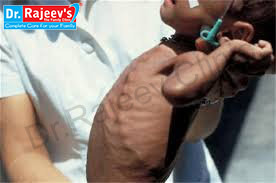

Rickets is a skeletal disorder that’s caused by a deficiency of vitamin D, calcium, or phosphate. These nutrients are important for the development of strong, healthy bones. People with rickets may have weak and soft bones, stunted growth, and, in severe cases, skeletal deformities.
Adding vitamin D or calcium to the diet generally corrects the bone problems associated with rickets. When rickets is due to another underlying medical problem, your child may need additional medications or other treatment. Some skeletal deformities caused by rickets may require corrective surgery.
Rare inherited disorders related to low levels of phosphorus, the other mineral component in bone, may require other medications.

Signs and symptoms of rickets can include:
Because rickets softens the areas of growing tissue at the ends of a child's bones (growth plates), it can cause skeletal deformities such as:
Child's body needs vitamin D to absorb calcium and phosphorus from food. Rickets can occur if your child's body doesn't get enough vitamin D or if his or her body has problems using vitamin D properly. Occasionally, not getting enough calcium or lack of calcium and vitamin D can cause rickets.
Children who don't get enough vitamin D from these two sources can develop a deficiency:
Some children are born with or develop medical conditions that affect the way their bodies absorb vitamin D. Some examples include:
Factors that can increase a child's risk of rickets include:
Left untreated, rickets can lead to:
Exposure to sunlight provides the best source of vitamin D. During most seasons, 10 to 15 minutes of exposure to the sun near midday is enough. However, if you're dark-skinned, if it's winter or if you live in northern latitudes, you might not be able to get enough vitamin D from sun exposure.
In addition, because of skin cancer concerns, infants and young children, especially, are warned to avoid direct sun or to always wear sunscreen and protective clothing.
To prevent rickets, make sure your child eats foods that contain vitamin D naturally — fatty fish such as salmon and tuna, fish oil and egg yolks — or that have been fortified with vitamin D, such as:
Check labels to determine the vitamin D content of fortified foods.
Calcarea fluorica
Rachitic enlargement of the femur in infants Enlargement of bones, with or without caries.
Swelling of bones of the jaw after extraction of teeth with violent pains.
Mercurius
Violent bone pains, with swelling.
Weakening in limbs Trembling in hands Cold sweat on legs at night
Phosphorus
Arms and hands become numb Patient can lie only on right side Burning in feet with weakness and trembling.
Calcarea phosphoric
A great remedy for non-union of fractured bones when due to impaired nutrition.
Stiffness and pain with cold, numb feeling Pain in joints and bones
Ruta graveolens
Especially useful where non-union results, because of deficient callus.
Pain and stiffness in wrists and hands.e.t.c